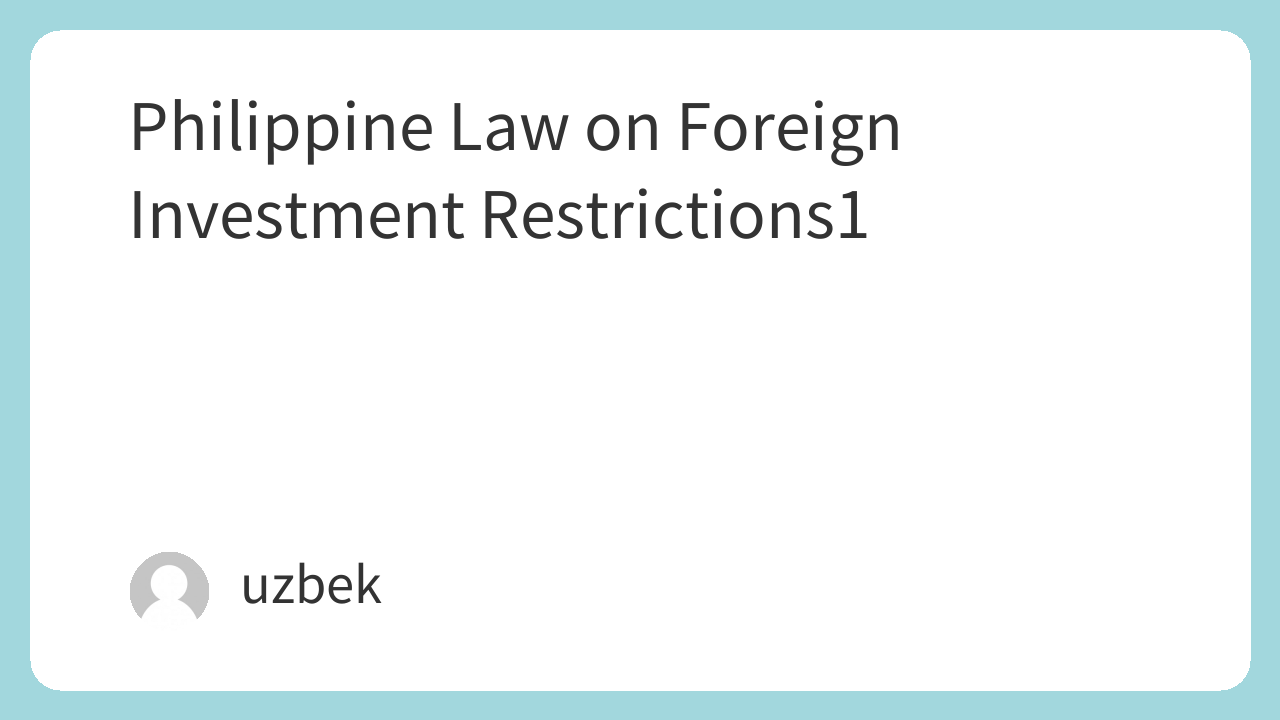Restrictions on the investment ratio of foreign investors in the Philippines are stipulated in the Foreign Investments Act of 1991 and the Foreign Investment Negative List (FINL) . Rather than a strict minimum of 51%, the restrictions vary by industry , with some sectors requiring a minimum of 60% investment by Filipinos, while others allow 100% foreign ownership.
We have compiled the original information from public institutions, as well as Japanese translations and summaries.
Philippine Law on Foreign Investment Restrictions
1. Article 3 of the Foreign Investments Act of 1991
- Original text (excerpt) : “a. the term “Philippine National” shall mean a citizen of the Philippines or a domestic partnership or association wholly owned by citizens of the Philippines; or a corporation organized under the laws of the Philippines of which at least sixty percent (60%) of the capital stock outstanding and entitled to vote is owned and held by citizens of the Philippines…”
- URL :
https://investmentpolicy.unctad.org/investment-laws/laws/587/philippines-an-act-promoting-foreign-investments (UNCTAD's Investment Policy Portal) - Translation : "a. The term 'Filipino national' means a citizen of the Philippines or a domestic partnership or association wholly owned by citizens; or a corporation organized under the laws of the Philippines, at least 60 percent of whose issued and voting capital stock is owned and held by Filipino citizens …"
- summary :
This provision defines what entities are considered "Filipino citizens." In the case of a corporation, one of the conditions for a company to be considered a "Filipino citizen" is that 60% or more of the voting shares are owned by Filipino citizens . This definition indirectly serves as the basis for setting a minimum investment threshold for Filipinos in certain industries.
2. The Concept of the Foreign Investment Negative List (FINL)
- Original text (excerpt) : "The Philippines' FINL is an executive order that governs where foreign entities are prohibited from investing. This legislation outlines the business sectors in the Philippines that are fully and partially available for foreign investment."
- URL :
https://philippines.acclime.com/guides/foreign-investment-negative-list/ (Explanation by Acclime Philippines)
https://investmentpolicy.unctad.org/investment-laws/laws/587/philippines-an-act-promoting-foreign-investments (UNCTAD) - Translation : "The Philippine FINL is a Presidential Decree that defines areas in which foreign investment is prohibited. This law outlines the business sectors in the Philippines in which foreign investment is permitted, either fully or partially." "g. The term 'Foreign Investment Negative List' or 'Negative List' means the list of areas of economic activity in which foreign ownership is limited to a maximum of 40% of the capital of the enterprises engaged in that business ."
- summary :
The Foreign Investment Negative List (FINL) is a list of industries where the Constitution and certain laws restrict the percentage of foreign investment . The list has different restrictions depending on the industry, and in most cases the foreign investment ratio is limited to 40% (i.e., Filipinos must hold at least 60%) . The 12th edition is currently in effect.
3. Examples of industries where the negative list restricts the ratio of foreign capital
In FINL (List A), for example, the foreign capital ratio is limited to 40% or less (Filipino ratio is 60% or more) in the following industries:
| Industry (English) | Industry (Japanese) | Maximum foreign capital ratio | Exceptions/Notes |
|---|---|---|---|
| Mass Media | Mass media | 0% (total ban) | Exceptions include recording and internet-related businesses |
| Practice of professions | Professional practice (e.g., law, medicine) | 0% (total ban) | There are conditional exceptions based on reciprocity agreements |
| Construction and repair of locally funded public works | Locally funded public works construction and repair | 40% | Foreign-funded projects are an exception |
| Exploration, development and utilization of natural resources | Exploration, development and utilization of natural resources | 40% | Exceptions include technical assistance agreements with the President |
| Ownership of private lands | Private land ownership | 0% (prohibited in principle) | There are exceptions, such as former Philippine-born citizens. |
| Operation of public utilities | Public works operations | 40% | 2022 amendment to the Public Service Act will allow 100% foreign ownership in telecommunications and other sectors |
| Educational institutions | Educational institutions | 40% | Exceptions include schools established by religious organizations |
| Advertising | Advertising industry | 30% |
4. When 100% foreign capital is possible
Importantly, not all industries require 51% or more Filipino ownership .
- Industries not listed in FINL : Under the Foreign Investment Law, it is possible to establish a corporation with 100% foreign capital .
- Export companies : Export companies that export more than 60% of their production can be 100% foreign-owned , unless they are listed in FINL.
- Minimum capital requirement : In principle, a 100% foreign-owned company operating in the domestic market must have a paid-up capital of US$200,000 . However, this can be reduced to US$100,000 if the company meets certain conditions, such as being a cutting-edge technology company, being certified as a start-up, or creating 15 or more direct jobs.
summary
- Legal Basis : Restrictions on Filipino ownership are regulated by the Foreign Investment Act (Republic Act No. 7042) and the Foreign Investment Negative List (FINL) periodically published thereunder.
- Regulations : There is no single rule that says "Filipinos must always account for at least 51% of the total," but rather it varies by industry .
- In industries listed on FINL's List A (fields regulated by the Constitution and laws), the foreign capital ratio is generally 40% or less (Filipino ratio 60% or more) .
- For industries not listed in FINL and export companies, it is possible to establish a company with 100% foreign capital .
- How to find information : The latest FINL is issued as a presidential decree. To find the original text, you need to search for the presidential decree in the Official Gazette or on the websites of public agencies such as the SEC (Securities and Exchange Commission) and NEDA (National Economic and Development Authority) . To understand the concept and content, we referred to databases of international organizations that cite relevant laws and commentary pages by local experts.
If you are considering expanding into the Philippines, the first step in determining your investment ratio is to check whether the industry you want to enter is listed on the Foreign Investment Negative List (FINL) .




コメント